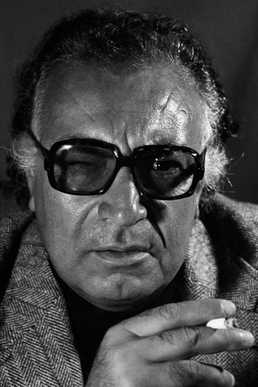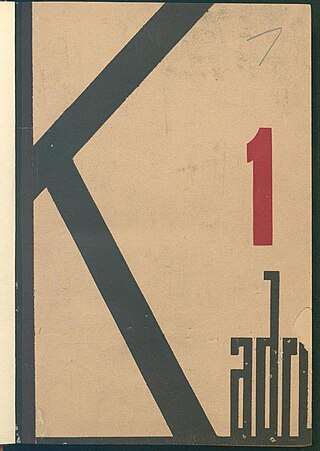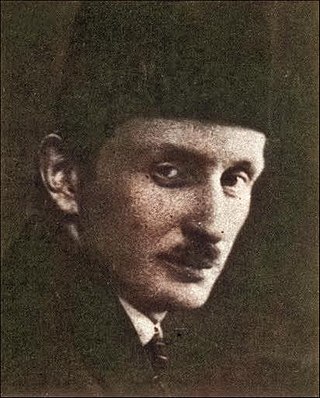Related Research Articles
Turkish literature comprises oral compositions and written texts in the Turkish language. The Ottoman form of Turkish, which forms the basis of much of the written corpus, was highly influenced by Persian and Arabic literature, and used the Ottoman Turkish alphabet.

Yaşar Kemal was a leading Turkish writer and human rights activist of Kurdish origin. He received 38 awards during his lifetime and had been a candidate for the Nobel Prize in Literature on the strength of his 1955 novel Memed, My Hawk.

Ahmet Hamdi Tanpınar was a Turkish poet, novelist, literary scholar and essayist, widely regarded as one of the most important representatives of modernism in Turkish literature. In addition to his literary and academic career, Tanpınar was also a member of the Turkish Parliament between 1944 and 1946.

Kadro was an influential left-nationalist and left-Kemalist magazine published in Turkey between January 1932 and December 1934. The title of Kadro translates from Turkish as "cadre".

Ömer Seyfettin, was a Turkish writer from the late 19th to early 20th century, considered to be one of the greatest modern Turkish authors. His work is much praised for simplifying the Turkish language from the Persian and Arabic words and phrases that were common at the time.
Varlık is a monthly Turkish literature and art magazine. Established by Yaşar Nabi Nayır, Sabri Esat Siyavuşgil, and Nahit Sırrı Örik in 1933, it often publishes poetry and works of famous Turkish poets and writers.
Halide Nusret Zorlutuna was a Turkish poet and novelist.

Nurduran Duman is a Turkish poet, writer, translator, editor, culture & art journalist.
The time that can be called contemporary in Turkish literature falls in the period between the middle of the 20th century and the first years of the new millennium. Throughout this period many changes in literary discourse have occurred. Together with the fall of the Ottoman Empire and foundation of the Turkish Republic brought a different way to Turkish literature together with the effect of Westernization on Turkish writers. The literature of the new republic emerged largely from the pre-independence National Literature movement, with its roots simultaneously in the Turkish folk tradition and in the Western notion of progress. One important change to Turkish literature was enacted in 1928, when Mustafa Kemal initiated the creation and dissemination of a modified version of the Latin alphabet to replace the Arabic-based Ottoman script. Over time, this change—together with changes in Turkey's system of education— would lead to more widespread literacy in the country. In 1950s, Turkish authors started to write in the tone of their western contemporaries bringing a new sense of literature to the country.
Bütün Dünya is a monthly Turkish periodical.
Mahmut Makal was a Turkish writer, poet and teacher who initiated the "Village Literature" movement in 1950 with the publication of his book ‘Bizim Köy’. This was translated into English as 'A Village in Anatolia' and published in 1954.
Yeni Dergi was a monthly cultural magazine which was published in Istanbul, Turkey, between 1964 and 1975. The magazine featured both translations and original texts from different fields.
Ülkü was a magazine existed between 1933 and 1950. It was one of seventy-five official media outlets of the People's Houses, cultural institutions started in 1932 as an enlightenment project. The title of the magazine was given by Mustafa Kemal Atatürk, founder of the Republic of Turkey.
Hanımlara Mahsus Gazete was an Ottoman women's magazine which was published in Istanbul from 1895 to 1908. It was one of the long-term publications in the Ottoman Empire which shaped the literary traditions of the Ottoman women. However, due to the intensive censorship during the reign of Sultan Abdulhamit the magazine mostly featured conventional topics.
Yurt ve Dünya was a sociological and political magazine which was headquartered first in Ankara and then in Istanbul, Turkey. It was first published in the period between 1941 and 1944 and then between 1977 and 1980. It is known for its well-known editors and contributors, including Sabahattin Ali, Niyazi Berkes, Behice Boran and Pertev Naili Boratav.

Refik Durbaş, Turkish poet, journalist and writer.
Birikim is a leftist magazine which has existed since 1975 in Turkey. It was banned by the military authorities in 1980 immediately after the coup. The magazine resumed its publication in 1989. It was a print magazine under the subtitle Aylık sosyalist kültür dergisi until 2005 when it was redesigned as an online publication.
İnsan was a cultural magazine which existed in Istanbul, Turkey, between 1938 and 1942. It was one of the journals started and edited by Hilmi Ziya Ülken who is one of the notable thinkers in Turkey.
Adımlar was a literary and political magazine which appeared in Ankara, Turkey, between May 1943 and April 1944. Its subtitle was Aylık Fikir ve Kültür Dergisi. It is known for its cofounder, owner and editor-in-chief Behice Boran, a Turkish socialist politician, and for its introduction of humanist approach towards literature in the country.
Fevzi Lütfi Karaosmanoğlu (1900–1978) was a Turkish landowner, politician, writer and journalist. He was a member of the Parliament for three times in the 1950s and in the early 1960s. He briefly served as the minister of state and minister of interior in the cabinets formed by the Prime Minister Adnan Menderes. Throughout his political career Karaosmanoğlu was part of various political parties.
References
- 1 2 3 4 5 6 7 Aslı Uçar (2007). 1950'ler Türkiyesinde Edebiyat Dergiciliği: Poetikalar ve Politikalar (MA thesis) (in Turkish). Bilkent University. pp. 66–71. ISBN 9798426846845. ProQuest 2665129039.
- 1 2 Kenan Behzat Sharpe (2021). "Poetry, Rock 'n' Roll, and Cinema in Turkey's 1960s". Turkish Historical Review. 12 (2–3): 358, 361. doi:10.1163/18775462-bja10028. S2CID 245625176.
- 1 2 Cangül Örnek (2013). "'The Populist Effect':Promotion and Reception of American Literature in Turkey in the 1950s". In Cangül Örnek; Çağdaş Üngör (eds.). Turkey in the Cold War. Ideology and Culture (1st ed.). London: Palgrave Macmillan. p. 153. doi:10.1057/9781137326690_7. ISBN 978-1-137-32669-0.
- 1 2 3 4 5 "Hüsamettin Bozok" (in Turkish). Türk Edebiyatı İsimler Sözlüğü. Retrieved 1 January 2024.
- ↑ Kemal H. Karpat (1960). "Social Themes in Contemporary Turkish Literature: Part I". The Middle East Journal . 14 (1): 38. JSTOR 4323199.
- ↑ Ayşenaz Cengiz (2020). "The Journey of Sartrean Existentialism into Turkey". In Alfred Betschart; Juliane Werner (eds.). Sartre and the International Impact of Existentialism. Cham: Palgrave Macmillan. p. 233. doi:10.1007/978-3-030-38482-1_12. ISBN 978-3-030-38482-1. S2CID 219100035.
- ↑ Başak Önsal (2006). Emergence of art galleries in Ankara: a case study of three pionerring galleries in the 1950s (Master of Science thesis). Middle East Technical University. p. 78. hdl:11511/16593.